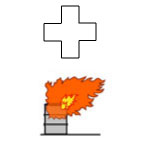| Case Name |
Fire during hot melting work for a valve blocked with hydrocarbons |
| Pictograph |

|
| Date |
September 25, 1991 |
| Place |
Sakai, Osaka, Japan |
| Location |
Chemical factory |
| Overview |
There was a fire at the laboratory of a chemical factory. The fire broke out when hot melting work for the pipe line was carried out because the flow meter for experimental equipment was clogged. Considering that the hot melting work and remounting work were conducted with the drain valve opened, and a dryer that could become an ignition source was used, a lack of hazard awareness was the main cause of this accident. |
| Incident |
There was a fire in the laboratory of a chemical factory. At an experimental apparatus for producing cyclododecanone and cyclo dodecanol through air oxidation using cyclododecane as a catalyst, there was plugging of a flow meter on the piping, in which 50 L of a liquid mixture of cyclododecane, cyclododecanone, and cyclododecanol was sent to the extractor. During cleaning and adjustment work for plugging, a fire occurred. |
| Processing |
Research and development |
| Process Flow |
Fig2.Unit process flow
|
| Substance |
Cyclododecane, Fig3 |
| Cyclododecanone, Fig4 |
| Cyclododecanol, Fig5 |
| Type of Accident |
Fire |
| Sequence |
As there was something wrong with the flow meter from the day before the accident, it was removed and cleaned, then remounted at its original position, and examined. No flow was observed. A fire occurred when plugging of the drain valve and piping was heated by melting using a dryer after opening the drain valve upstream from the flow meter. |
| Cause |
Hot melting of the plugged material with a dryer made the liquid mixture spout out from the opened drain valve. The heated part of the dryer seems to have been the fire source. |
| Response |
Cooling and fire extinguishing activities with a foam extinguisher by a fire fighting team were conducted with a chemical fire engine and a high point pour water engine. |
| Countermeasures |
The direction of the draw-off mouth and the draw-off flow rate were adjusted to reduce the hazards. Any instrument that could become an ignition source was banned and other electrical appliances in the laboratory were made explosion-proof. A ribbon heater to keep the piping warm was equipped with a temperature control device so that the temperature of the piping never should reach the boiling point of a solvent. |
| Knowledge Comment |
In the case of an unusual operation, it should be known that hazard prevision is useful for accident prevention. |
| Background |
Conducting hot melting work for plugging recovery with an open valve, and use of a naked flame (dryer had a naked flame) for melting combustibles were mistakes. These two operations, which deviated from the safe standard, were the direct causes of this accident. In another words, a safety management error caused the accident. |
| Sequel |
The damaged person seemed to get burnt due to the dryer he had and suffered from oxygen deficiency due to combustion gas, and died. |
| Reason for Adding to DB |
Example of fire caused due to lack of hazards prediction |
| Scenario |
| Primary Scenario
|
Ignorance, Insufficient Knowledge, Insufficient Study /ExperienceInsufficient Study/Experience, Carelessness, Insufficient Understanding, Insufficient Recognition of Risk, Organizational Problems, Poor Management, Slackness of Management, Non-Regular Movement, Movement During Transition, Operation at Plugging, Malicious Act, Rule Violation, Safety Rule Violation, Secondary Damage, External Damage, Leakage/Fire, Bodily Harm, Death
|
|
| Sources |
High Pressure Gas Safety Inst. of Japan, Cyclododecane experimental equipment, Fire at blocked valve during hot-melting work. Accident examples of Petroleum refinery and Petrochemical units, pp.205-207(1995)
Assoc. for Safety Technic of Dangerous Materials, Accidents of hazardous materials, Cases of accidents with hazardous material seminar, pp.90-91(1996).
|
| Number of Deaths |
1 |
| Physical Damage |
A laboratory of about 20 square meters, facilities for electricity and instrumentation were destroyed by fire. |
| Financial Cost |
Under ¥ 10,000. (Fire and Disaster Management Agency). |
| Multimedia Files |
Fig3.Chemical formula
|
|
Fig4.Chemical formula
|
|
Fig5.Chemical formula
|
| Field |
Chemicals and Plants
|
| Author |
ARAI, Mitsuru (Environmental Science Center, The University of Tokyo)
TAMURA, Masamitsu (Center for Risk Management and Safety Sciences, Yokohama National University)
|
|